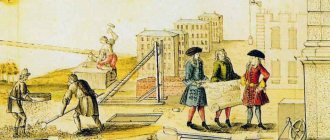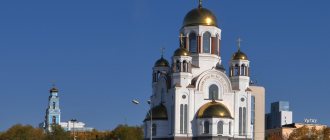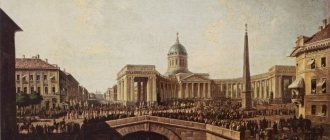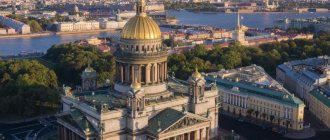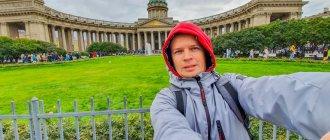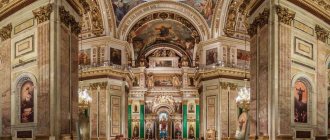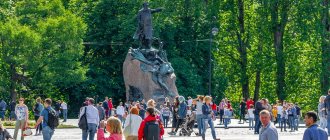I want to introduce you to the famous St. Petersburg architectural monument - a temple made in the Baroque style. Its full name is St. Nicholas Naval Cathedral.
I have loved visiting it since my student days, when my friends and I always came here during session time to see the amazing miraculous icon of St. Nicholas of Myra. By the way, I want to emphasize that this saint is the patron saint not only of sailors, but also of all travelers. That’s why I invite you, if possible, to definitely visit this temple, named after him.
In my opinion, the history of the city on the Neva is revealed to us not only by the fate of the individuals who created it, but also by all those wonderful artistic and scientific masterpieces they created. And I myself learned with great interest how the temple, which appeared as an ordinary parish church in Morskaya Sloboda, was destined by fate to eventually become a majestic monument to the glory of our Russian fleet.
The history of the creation of St. Nicholas Cathedral
The entire history of St. Petersburg seems to me to be blown by the winds of the Baltic. She is simply inseparable from the sea. After all, at first the life of the city itself was concentrated precisely near the main shipyard - the Admiralty. By the way, you can read about the Admiralty and the magnificent Alexander Garden around it in my article here.
Further, behind the Admiralty esplanade (i.e., the undeveloped space near the fortress) there was the Morskaya Sloboda, where the creators of the great Russian fleet lived.
St. Nicholas churches - predecessors of the cathedral
I’ll tell you that for the spiritual support of the local population in that area, at first there was a chapel in honor of St. Nicholas the Pleasant. I mentioned that this saint has always been considered the patron saint of sailors, so this name was not accidental. It was replaced in 1743 by a wooden church, whose flock already at that time numbered more than 3 thousand people (excluding women and children). But due to the dampness of St. Petersburg, this temple gradually fell into disrepair. And so, at the request of the President of the Admiralty Collegium, Prince Mikhail Golitsyn, Lady Elizaveta Petrovna agrees to replace it with a stone one.
I want to preface the further story with one legend. According to him, Peter I, who once saw the magnificent Assumption Cathedral in Astrakhan, wished the same for St. Petersburg.
This did not happen during the king’s lifetime, but his will was not forgotten. The emperor's daughter decided to bring her father's plan to life. In her opinion, the new temple was to be built “In retribution of the worthy memory of the glorious deeds of the Russian fleet...”
Creation of St. Nicholas Naval Cathedral
The project plan was developed by the architect of the Admiralty Collegium S.I. Chevakinsky and envisaged the construction of a building with a high foundation so that during frequent floods the floor of the temple would not be flooded with water. The foundation of the cathedral took place in June 1753 not far from the Kryukov Canal.
The temple was built “in two apartments,” that is, on 2 floors. Its vaults are made in the shape of an equal-armed cross. The building is decorated with graceful columns on the pedestals. Just like the Astrakhan Assumption Church, St. Nicholas Cathedral is crowned with five golden domes with openwork crosses.
Thus, Elizaveta Petrovna returns to St. Petersburg the tradition of “multi-bulb” native Russian architecture. After all, initially the churches in the city were single-domed, the bell towers had spiers, and the church spaces were of the “hall type” (for example, the Peter and Paul Cathedral, which you can read about in my article here).
Work on decorating the interior began as soon as the walls were erected under the roof. Sketches of the iconostases for both churches were also made by Chevakinsky, and they were created by Admiralty carvers under the direction of I.F. Kanaev. The iconostases were installed in 1760.
At the same time, icons were painted for them.
I have always been attracted by the rule of icon painters to take a blessing for their work and fast while painting images. An artist friend who participated in the painting of one of the St. Petersburg churches told me in detail about this. And I also heard the opinion of one famous modern icon painter that the main thing in such work is the connection with God. Without internal combustion nothing will happen...
I think that you and I, who come to churches and see frescoes and icons, are certainly conveyed some of the reverence of the masters who created them. In St. Nicholas Cathedral, this important task was entrusted to the Kolokolnikov brothers - Mina, Ivan and Fedot, one of the best church painters in St. Petersburg at that time. The icons were painted by them in a style that combined canonical church techniques and the manner of secular European painting.
In addition, I draw your attention to the fact that in the iconostasis of the church on the second floor one can clearly discern the “state shade”: the image of the Apostle Peter, St. Elizabeth, St. Catherine, St. Ianuaria, on whose memorial day Peter III was born. You can also see the icons of Clement of Rome and Peter of Alexandria, on their day Peter’s daughter ascended the throne.
That is, I want to show once again how spiritual buildings preserve the history of days gone by. Only they tell it in their “heavenly” language. After the installation of the iconostasis, the creation of the internal splendor of the cathedral continued. I note that the upper temple was intended to be more ceremonial.
Therefore, a gilded gate, cut out like lace, and a pulpit were installed there for reading sermons, pronouncing imperial orders and reports about the triumphs of the country's fleet. Also in the upper “apartment” there was a “royal place” decorated with cherry velvet.
On the ceiling, instead of the usual image of the four evangelists (which were placed in the very central drum), there was the coat of arms of Russia, supported by angels and the monogram “E I”, which belonged to the daughter of Peter I. When I visit churches, I always pay attention to the chandelier (central chandelier). For Nikolsky it was delivered from Nuremberg.
The exterior decoration of the temple begins in 1756. I would like to add that the Tula factory owner P. A. Demidov took part in the construction of the domes and crosses.
It was common practice for industrialists of that era to give generous aid to churches. Simultaneously with the construction of the cathedral, the construction of a belfry began, located to the west of it. The work was completed in 1758. The elegant building was decorated with chimes.
I read that in those days this bell tower had the best set of bells in the capital. There were 13 of them in total.
Consecration of the cathedral
The lower temple had three chapels. On the eve of Winter St. Nicholas Day, as it is popularly called, on December 5, 1760, the central chapel, St. Nicholas, and the right chapel are consecrated in memory of the Beheading of John the Baptist. The third, left side chapel, was consecrated on July 20 in 1762 already under Catherine II in honor of St. Dmitry of Rostov, who compiled the church ceremonies-menaions (a book of the lives of Orthodox saints according to the months of their memory).
At the same time, the upper temple was consecrated in honor of the Epiphany. It was this empress who “orally commanded” to call the temple the Naval Cathedral, which determined its entire future fate.
I am pleased to report that St. Nicholas Cathedral has miraculously managed to preserve for you and me the flavor of that former era. After construction, the temple changed little.
In the middle of the 19th century, only the gates of the main aisle in its lower part were replaced and the wooden spans leading to the second floor were made of stone. At the beginning of the 20th century, St. Nicholas Cathedral was given to the Naval Department, under whose leadership heating stoves were installed in it. In 19113, the merchant of the 1st guild A.I. Ivanov granted the cathedral a Throne and an Altar of unique work.
St. Nicholas Chapel at the beginning of the 18th century
From the very beginning of the founding of St. Petersburg, vigorous work was carried out on the construction of vital facilities. The Peter and Paul military fortress was built on Hare Island near the right bank of the Neva, the Kronstadt military fortress was built on Kronshlot Island in the Neva Bay of the Gulf of Finland. Admiralty - the main shipyard was built on the left bank of the Neva opposite the Peter and Paul Fortress. Behind the Admiralty, across the Moika River, lay the vast Morskaya Sloboda. The construction of ships was carried out by a large number of Russian Orthodox craftsmen, for whose spiritual nourishment a chapel was built on the territory of Morskaya Sloboda. It was consecrated in honor of St. Nicholas the Wonderworker, the heavenly patron of sailors.
Temple-monument to the heroic fleet of Russia
I told you how the church, conceived in Morskaya Sloboda as usually a parish church, gradually turned into a grandiose naval cathedral. Since the reign of Catherine II, all Russian naval victories have been celebrated there.
For example, the date of the triumph of our fleet over the Turkish is September 14, 1770. When the famous and revered by me (now the only holy admiral) F.F. Ushakov completely defeated the enemy at Chesma.
Such events were celebrated very solemnly with thanksgiving prayers in the presence of the most brilliant families of Russia, famous naval commanders and clergy. A ceremonial military formation was certainly organized in front of the temple, and fireworks followed the prayer service.
Soon after 1773, on June 24, a holiday in honor of the Russian Navy began to be traditionally celebrated here in a similar way. I note that the prayer services were led by the bishop himself. Empress Catherine II, remembering the victories at sea in 1770–1790, generously donated 10 icons in gold vestments to the cathedral. The images corresponded to specific battles that took place on the days of the saints depicted on them. Among them: the Chesma victory (1770), the battle of Balaklava (1773), the capture of Ochakov (1788), the Battle of Revel (1790), etc.
Icons were also donated to the Naval Cathedral by the ship crews themselves or specific sailors.
I am sure that you have all heard about the tragic battle for the Russian fleet near the island of Tsushima (May 14, 1905). All our ships were destroyed there.
I immediately remember a thick book with the same name - a novel by Alexei Silych Novikov-Priboi, which I read as a child.
It was decided to immortalize the memory of those killed on the battleships “Emperor Alexander III”, “Petropavlovsk”, the 1st rank cruiser “Admiral Nakhimov”, on the ships “Ural”, “Gromoboy” and “Izumrud” with a monument in a public park laid out according to the project of that Chevakinsky, near St. Nicholas Cathedral. The opening of the monument took place on May 14, 1908 (author Ya. I. Filotey).
In the cathedral there was the full complement of the Guards crew, Tsarina Maria Feodorovna, members of the royal family and relatives of the victims.
In the first years of Soviet power, the boards with the names of the sailor crews were lost and only partially recreated in 1973.
I note that in imperial times, it was customary to install boards in regimental churches with the names of fallen heroes. After the revolution, similar ones were preserved only in St. Nicholas Cathedral.
I will never understand how and why someone dared to destroy the historical memory of the best sons of the Fatherland, who heroically gave their lives during battles.
I would like to note that from 1870 until the revolution, a charitable society operated in the cathedral, there was a school, a hospital, an orphanage and an almshouse for elderly and infirm women.
Interior and values
The interior of the cathedral repeats its exterior decoration and is unique , since objects of that time in St. Petersburg are almost completely lost.
Interior decoration
Carved, gilded iconostases , made according to the sketches of Savva Chevakinsky , are located in the upper and lower churches. They are decorated with icons made by the Kolokolnikov masters. Excellent wood carving was performed by master Ignatiy Kanaev. The silver utensils for the temple were made by an unknown capital jeweler.
The upper church has a particularly rich interior:
- the vaults are decorated with a gilded copper chandelier made in Germany
- the gate leading to the altar resembles golden lace
- a “royal place” was arranged, decorated with gold carvings and upholstered in crimson velvet
Tsar's decrees were read out from the pulpit of the upper church and Russia's naval victories were announced.
Shrines
The cathedral houses about three dozen images of especially revered saints, including:
- Tikhvin Icon of the Mother of God
- Kazan Icon of the Mother of God
- Vladimir Icon of the Mother of God
- icon of the great martyr and healer Panteleimon
- icon of Saint Blessed Xenia of Petersburg
The main shrine of the cathedral is the image of St. Nicholas the Wonderworker with particles of his relics. This saint is considered the patron saint of travelers, therefore he is especially revered by sailors. The 18th-century icon was donated by Greek sailors.
The particle of the relics , which is in the medallion, was presented as a gift by the Metropolitan of the Mount Lebanon in 1947. in the altar part of the lower church .
Another value of the cathedral is the reliquary with particles of the relics of many revered saints, including:
- John the Baptist
- Andrew the First-Called
- healer Panteleimon
In the center of the reliquary is a piece of the Life-giving Cross of the Lord , which was given to the cathedral by Patriarch Kirill of Moscow and All Russia in 2010.
St. Nicholas Naval Cathedral under the USSR
Years of repression
The arrival of the atheistic Soviet power in Russia immediately affected the life of St. Nicholas Cathedral. It no longer belonged to the jurisdiction of the Guards crew, but became an ordinary parish church.
I am not happy to tell you that in 1922 all funds, as well as church valuables, were confiscated from it. True, the believers, giving their last, bought back their part, bringing in silver equal in weight to them. I note that it was St. Nicholas Cathedral in 1923 that became the center for the fight against the Renovationist Church. True, he still fell into the hands of the renovationists for a short time, but in January 1924 he again returned under the wing of the true church. Icons and relics from other churches that were being closed and destroyed began to flock to the temple. And I would like to emphasize that St. Nicholas Cathedral in those days not only continued to preserve the memory of the heroic history of our fleet, but also acted as a defender of Orthodox shrines. But the history of the Russian state is also connected with each of them.
For example, the “Burning Bush” icon from the Imperial School of Law with a dedicatory inscription on the back made by the daughter of the founder, Prince Peter of Oldenburg, arrived at the St. Nicholas Church. Also, a reliquary was transferred here - a gift to St. Petersburg from the Russian Panteleimon Monastery from the Greek Mount Athos and many other shrines that were saved from destruction.
I have already told you about the beautiful belfry of the cathedral. The new authorities did not spare her either. Today it sounds ridiculous, but by decree of June 27, 1933, the ringing of bells over Leningrad was generally prohibited.
And so, on July 9, 1934, all 13 magnificent bells, whose weight exceeded 20 tons, were thrown from the bell tower of the Naval Cathedral. The looting of valuables and arrests of clergy continued. It pains me to give you the facts, but there is no escape from them.
Before the revolution of 1917, there were about 500 Orthodox churches (houses attached to organizations, parishes, cathedrals) in St. Petersburg. By 1941, only 8 of them and only 20 “surviving” priests remained in Leningrad, five of whom served in the St. Nicholas Church.
Spiritual battle in besieged Leningrad
The Great Patriotic War broke out. St. Nicholas Cathedral receives cathedral status. Metropolitan Alexy (Simansky), the future Patriarch, serves (and lives) here. I believe that we should be proud of such people. This hierarch did not escape from trouble by evacuation, but shared with his people all the hardships of the blockade.
By the way, services were held in the temple every day! On the initiative of Bishop Alexy, already on June 23, 1941, the cathedral began collecting donations from the flock for the needs of the front. The Leningrad Metropolitan himself read out the commemorations every day, served a prayer service to St. Nicholas the Wonderworker, and then walked around the St. Nicholas Cathedral with icons, praying for the preservation of the city and the cathedral from destruction. I read about what the future patriarch had to personally endure, how courageously he supported numerous Leningrad parishioners.
With the beginning of the Great Patriotic War, attitudes towards the church changed. Now, since 1942, religious processions were held on Easter, religious institutions and churches were opened. Alexy (Simansky), along with other priests of the St. Nicholas Church, was awarded the medal “For the Defense of Leningrad” in 1943.
By the way, I consider it very significant that in May 1944, Vladyka gave up his dacha at Siverskaya station for an orphanage. I know this because our relative worked there as a teacher.
I would like to give you one more figure characterizing the activities of the temple and its clergy during the war years. The total monetary contribution for the needs of the front from the St. Nicholas Naval Cathedral was equal to 4,703,598 rubles. Only the Moscow Elokhov Cathedral made a larger donation.
The temple, damaged by shelling, was completely restored in 1953. His flock grew steadily. He survived the St. Nicholas Cathedral and the terrible “Khrushchev persecutions”. In 1966, the funeral service for poetess Anna Akhmatova was held here.
By the way, the director who filmed this memorial service was fired for being anti-Soviet.
On the eve of the celebration of the millennium of the Baptism of Rus' in 1988, church life in our country became surprisingly intensified. A mass of baptisms took place every day in St. Nicholas Cathedral, and the number of parishioners of all ages increased.
In addition to services and sacraments, priests could now also participate in educational and charitable activities.
Architecture of the complex
After completion of construction, the Cathedral of St. Nicholas the Wonderworker, whose height is 31.5 m, became the decoration of the street. Boat. Due to the fact that almost all residential buildings located next to the temple complex have only 5 floors, permission from Mosgosstroynadzor for the construction of a taller religious building was not received.
From afar, the temple complex bears some resemblance to a flagship frigate, which is quite natural, given that the cathedral was built as a spiritual center for workers in the maritime and river industries. This shape (an elongated quadrangle with a protruding front part) has been known for a long time and is a symbol of the ark for the salvation of souls.
The final project was approved in the style of Russian buildings of the 12th–14th centuries, repeating medieval Vladimir-Suzdal architecture. It was decided that the decoration of the walls of the building should copy elements that can be seen in Vladimir at the Dmitrov Cathedral and in Yuryev-Polsky at the St. George Church.
The Church of St. Nicholas the Wonderworker on Lodochnaya in Tushino (except for the frame, which was cast from monolithic concrete) was built of brick, which made it possible to enhance the acoustic effect inside the building. In addition, this building material is able to maintain a comfortable temperature and humidity regime, which is very important when the room is very full, for example, during holiday services.
The outer cladding is made in white. The main decorative elements include an arcature-columnar belt, pilasters with half-columns. The facade is decorated with tiles with decorative patterns and stucco molding, repeating examples of medieval architecture of the Vladimir-Suzdal principality (XII-XIV centuries).
The patterns used by the craftsmen to decorate the building include symbols typical of sailors and fishermen.
The cathedral has 3 chapels:
- Nicholas the Wonderworker;
- Tikhon, Patriarch of All Russia, who became the head of the Russian church after the fall of the autocracy;
- John the Theologian.
The temple complex, including the clergy house, occupies an area of 1.5 thousand square meters. m. (the area of the temple itself is 547 sq. m., the dimensions of the clergy house are 954 sq. m.) The capacity of the cathedral is small (up to 200 parishioners).
The parish house is 2-storey. It housed a kitchen, a small bakery and a prosphora. The building has special rooms for Sunday school classes and group work. Administrative offices are also located here.
The temple and temple grounds are adapted for people with disabilities. There are ramps installed here, and lecterns and candlesticks are of a height that allows wheelchair users to get around without assistance.
For people who have hearing problems, speakers are built into the walls of the building. To help visually impaired people better navigate their surroundings, there are tactile tiles on the walls and contrasting lines on the floor.
Temple today
And so today you and I can freely, without hiding and without worrying about subsequent repressions, enter this monument of architecture and art of the mid-18th century, accommodating up to 5,000 people.
I would like to please you that the temple managed to maintain its splendor the way it shone before kings, bishops and laymen of all classes for more than 250 years. Today (since 1987) the rector of this unique St. Nicholas Cathedral is Archpriest Bogdan Soiko.
I would like to draw your attention to the fact that in 1989 a memorial plaque was installed in the temple in honor of the deceased crew of the Komsomolets submarine. Some sailors managed to escape then; I even worked with one of them at one time. But the memorial plaque in honor of the Kursk submarine, which appeared in 2000, recalls the days of pain and bitterness for the entire dead crew, which we can see in the photo from the naval archive.
In the cathedral you will also find memorial plaques to crew members of other lost submarines. Since 2000, a chapel has appeared in the lower tier of the belfry. As before, as if continuing the imperial traditions, the temple maintains warm friendly ties with the command staff of the Navy and other military structures of our city and region.
The memory of the dead crews on diesel and nuclear submarines is honored here.
In the spiritual care of the temple there are: the chapel of the Nativity of Christ at the Rubin Research Institute, the chapel of St. Nicholas of Myra at the State Unitary Enterprise "Admiralty Shipyards", the chapel of St. Equal-to-the-Apostles Grand Duke Vladimir in the “St. Petersburg” TEST. St. Petersburg residents love to baptize children and get married here.
Also in the cathedral, abandoned children are baptized; a “Baptismal Certificate” is always included in their personal file.
Shrines of the cathedral
I think it will not surprise you that the main shrine located in the upper church is the miraculous icon of St. Nicholas.
If you wish, I suggest you read about the greatest saint, who is very loved in Rus', here. You can learn in detail about all other images and reliquaries here. I also strongly advise you, when visiting the cathedral, to venerate the image of St. Xenia of Petersburg, which is located in the central part of the upper church.
After all, it is she who patronizes the city in which your journey is currently taking place.
Social service
There are adult and children's Sunday schools at the church. Moreover, there are classes for preschoolers. A children's church choir has been created for children, and the children regularly participate in services themselves.
Boys, with the blessing of the abbot, can try themselves as altar servers. There's something for everyone here. You can study in beadwork, fine arts, and English clubs. Children's creative works are regularly presented at Diocesan Christmas and Easter exhibitions. For Christmas and Easter, Sunday school students themselves prepare concerts and performances, and the rector of the cathedral himself congratulates them on the holidays, presenting them with gifts.
And then adults and children take part in a festive meal. Sunday schools also often host excursions and pilgrimages.
The St. Nicholas Youth Union has been operating at the cathedral since 2010.
I would especially like to note that young men and women not only communicate and go on pilgrimages, but also visit homes for the disabled and orphanages, and help elderly members of the parish.
A library has been created and operates in the administrative building at the temple, where more than 3,000 books are presented.
Description of the cathedral
The temple consists of two churches: the upper one, consecrated in honor of the Epiphany , and the lower one, consecrated in honor of St. Nicholas the Wonderworker, Archbishop of Myra in Lycia. From above you can see that the cathedral has the shape of an equal-ended cross.
Brief information
Description of the cathedral in brief figures and facts:
- author of the architectural project – Savva Chevakinsky
- architectural style – baroque
- year of foundation – 1753
- completion of construction and consecration - 1762
- The capacity of the cathedral is about 5000 people
- number of domes - five
The cathedral is the brightest example of Baroque in Russian church architecture.
Exterior decoration
The bright blue facade of the temple has a festive look even in gloomy weather:
- snow-white Corinthian columns with capitals decorated with carved acanthus leaves and angelic faces
- molded trim in the form of flower garlands
- balconies with forged patterned grilles
- Golden domes
The image of the cathedral can often be found in paintings by St. Petersburg artists.
kseniyalesikova
provenceetmoi
sdnss._
lena_graffigna
Bell tower
By 1758, a four-tier bell tower was built next to the temple :
- a chapel was consecrated in the lower tier in 2000
- the middle tiers are a belfry with 13 bells
- There is a clock on the turret - chimes
- the upper dome is topped with a thin spire
The bell tower of the cathedral is one of the most recognizable and romantic buildings in St. Petersburg.
andrewvealokin
veter1874
kusudamochka
How to get there
This cathedral is located in the center of St. Petersburg on Nikolskaya Square no. 1-3. To get there, I usually take the metro to one of the Sennaya-Sadovaya-Spasskaya stations. (1).
They are all connected by transitions. You can exit in any direction (all exits are almost nearby). Further along Sadovaya Street I walk to Nikolsky Lane, as shown on the map. I like this path because along the way you can admire the Yusupov Garden (2) and the old architecture of the city. The entrance to the cathedral is located from the belfry (3) .
But for those who do not like walking, you can use ground transport.
From the metro you will be taken here by buses No. 49 and 181, tram No. 3, as well as minibuses K-7, K-124 and K-212. I admit, I never use them, because, in my opinion, walking is much more interesting, and sometimes faster.
Excursions
The cathedral offers three excursions regularly throughout the day:
- To the second tier
- Under the dome
- To the bell tower
Prices
For the dome - 400 rubles, the rest 250 and 150 according to the level of distance from the ground. In general, it’s worth going to the dome, but you can also go to the bell tower. If 400 is expensive, then you can push for pity. As in the Smolny Cathedral, all these amounts of money are, as it were, a “donation” and are not subject to taxes and are not fixed.
1
Entrance to the cathedral and time to visit it
You can enter here completely free of charge and almost every day from 6.45 to 20.00
I will only draw your attention to the fact that the upper church can only be visited during evening services on Saturdays and before church holidays (from 18.00), as well as from 10.00 (from the moment of the morning liturgy) on Sundays and holidays.
And in my opinion, it’s really worth it for you to come up here! After all, it is here that memorial plaques dedicated to the crews of Russian ships, including the Kursk and Komsomolets submarines, are located.
Please do not forget about the rules of behavior in the temple and try to have an appropriate appearance. To comply with these rules, I draw your attention to the hint located here.
Where to stay
The Church of St. Nicholas the Wonderworker on Lodochnaya in Tushino is visited not only by local residents, but also by city guests.
In close proximity to the temple complex there are a number of hotels where visitors can stay:
| Name | Address | Price | Distance |
| Hotel Domino (3 stars) | Svoboda street, 40, bldg. 2 | from 2,500 rub. room for 2 | 1 km (12 min.) |
| Economy Hostel "Comfort" | Fabricius street, 4 building 3 | 500 rub. (with 1 person) | 1.1 km (14 min.) |
| Hotel "Pokrovsky" (2 stars) | Svobody street, 1, bldg. 1З | 2000–2500 rub. | 2.5 km (30 min. on foot), or by bus: T, t70, 248, 06, 103, 62) |
But the closest is the Bannaya Estate. It is located at a distance of 440 m from the temple (5 min walk). Cost of living from 2500 rub. In addition, there is a bathhouse and sauna.
A large number of people who, in one way or another, are involved in the work of the maritime or river industry, took part in the construction of the Church of St. Nicholas the Wonderworker on Lodochnaya in Tushino. Entire enterprises and individual workers acted as donors.
The amounts contributed were also different. A list of the names of all those who made donations for the construction are immortalized on boards mounted on the walls at the entrance to the temple.
Author: Irina Zhuravka
Finally
I am proud that in the city where I live there is this wonderful cathedral, preserving the memory of the naval military glory of our country.
When you stand here at the service, with the flickering of the lamps and the glow of the candles, it seems that time has turned back. And you suddenly feel a sense of belonging to all those who once sincerely prayed here in times past.
You share their concerns for loved ones and relatives who are in distant seas and oceans in defense of the Fatherland. You rejoice at the general triumph in the days of Russia’s glorious victories. You participate in prayer services during the terrible time of siege. And it’s as if you see how the future Patriarch Alexy I, exhausted by hunger, but not broken in spirit, carries out the communion cup. This is an amazing place that connects our present with the past of our fathers, grandfathers and great-grandfathers.
And I am sure that no matter what denomination a person belongs to, when he enters the St. Nicholas Cathedral, finds himself in its majestic atmosphere and reads the names of the heroes on the memorial plaques, he will feel the spirit that has strengthened people’s hearts all these years.
